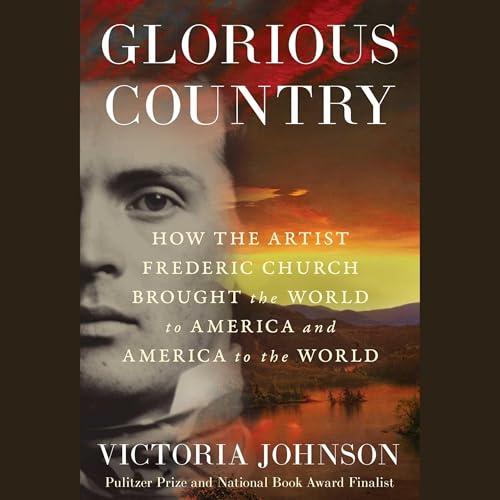
Glorious Country
How the Artist Frederic Church Brought the World to America and America to the World
Échec de l'ajout au panier.
Veuillez réessayer plus tard
Échec de l'ajout à la liste d'envies.
Veuillez réessayer plus tard
Échec de la suppression de la liste d’envies.
Veuillez réessayer plus tard
Échec du suivi du balado
Ne plus suivre le balado a échoué
0,00 $ pour vos 30 premiers jours
OFFRE D'UNE DURÉE LIMITÉE
0,99 $/mois pendant vos 3 premiers mois
L'offre prend fin le 16 décembre 2025 à 23 h 59, HP.
Exclusivité Prime: 2 titres
gratuits à choisir pendant l'essa. Des conditions s’appliquent.
Vos 3 premiers mois d'Audible à seulement 0,99 $/mois
1 nouveauté ou titre populaire à choisir chaque mois – ce titre vous appartiendra.
L'écoute illimitée des milliers de livres audio, de balados et de titres originaux inclus.
L'abonnement se renouvelle automatiquement au tarif de 0,99 $/mois pendant 3 mois, et au tarif de 14,95 $/mois ensuite. Annulation possible à tout moment.
Choisissez 1 livre audio par mois dans notre incomparable catalogue.
Écoutez à volonté des milliers de livres audio, de livres originaux et de balados.
L'abonnement Premium Plus se renouvelle automatiquement au tarif de 14,95 $/mois + taxes applicables après 30 jours. Annulation possible à tout moment.
Précommander pour 27,99 $
-
Narrateur(s):
-
Auteur(s):
-
Victoria Johnson
À propos de cet audio
“They came to see the world.”
New York, spring 1859. Outside Frederic Church’s Tenth Street studio, men and women amassed by the thousands hoping for a glimpse of his magnificent Heart of the Andes: a painting whose sublime, ‘near supernatural’ rendering of the vast Andean landscape encountered on the artist’s recent travels introduced thousands of Americans to the fierce, majestic beauty of the far-flung wildernesses of the globe.
Frederic Church brought the world to America, and America into the world. Cementing the United States as a cultural and artistic force a full century before America’s Abstract Impressionists rose to prominence, Church’s bold paintings composed odes in color, shadow, and light to natural places near and far: the lush jungles of South America and immense icebergs of Newfoundland where he journeyed as a young man; the Syrian deserts and ancient, ruined cities where he and his wife traveled following the devastating loss of their two young children; the verdant, luminous valley around the Hudson where Church first studied painting and where he returned and established his estate, Olana, whose landscape itself became a work of art. Deeply influenced by the work of Alexander von Humboldt, Church conjured a vision of the natural world as a place of communion with creation.
Church charted, across the latter half of the 19th century, a career that both inhabited and gave shape to the artistic, cultural, and political crosscurrents of his day. Through a close examination of Church's letters, sketches, paintings, and diaries, and traveling in Church's footsteps to Egypt, the Andes, Petra, Jamaica, and Jerusalem, Johnson traces the path not only of one man’s life, but of a country swept up in an era of vast and vertiginous change. Church worked and lived in New York in the city’s formative years. He was a founder of its first great museum, the Met, and in paintings, not in words, he conveyed his passion for the exquisite natural beauty of the United States, but also for a Union free of slavery. He gave Americans visions of the majesty of their own new country and of the wonders of worlds only to be seen in paintings by this astonishing adventurer and artist. Church was a master artist and innovator, turning landscape painting into a portrait of a nation, and in the process, putting American art on the map of the world. Glorious Country is a book, Johnson writes, “about how we see and what we save.”
Pas encore de commentaire


